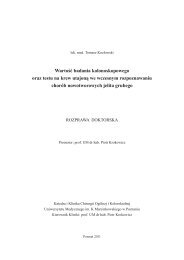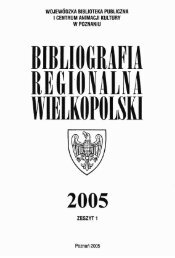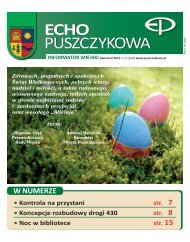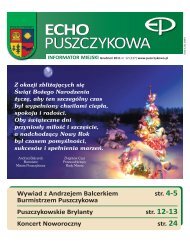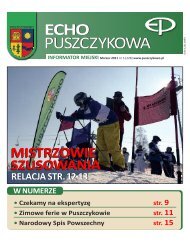MILITARY PHARMACY AND MEDICINE
MILITARY PHARMACY AND MEDICINE
MILITARY PHARMACY AND MEDICINE
Create successful ePaper yourself
Turn your PDF publications into a flip-book with our unique Google optimized e-Paper software.
© Military Pharmacy and Medicine • 2012 • 4 • 62 – 66pertains to cardiovascular and gastrointestinaldiseases, as well as to some cancers [1].Minerals are not synthesized in human bodyThey must be delivered to the body with foodand drinks in appropriate quantities and ratios.In special cases, they may be supplied as dietarysupplements to the food rations. Minerals playdual role in human body: they are either buildingmaterials (calcium, phosphorus, iron) or theyregulate the biochemical processes in the body(potassium, sodium, magnesium, copper, zinc)[2]. Many authors observed too low supply ofcalcium, magnesium and iron accompanied byexcess amounts of sodium and phosphorus indaily food rations of students [3,4].In the context of the important role of minerals inthe maintenance of good health, as well as prevalentabnormalities consisting in their too-low (calcium,magnesium, potassium, iron) or too-high(sodium, phosphorus) intake, appropriate supplyof these elements in food rations is reasonable.As shown by the studies of the nutritional habitsof Poles, these habits are far from current recommendations,also with regard to the supply ofappropriate standard amounts of minerals [5].Sodium and potassium are elements found inmany food products. Salt, i.e. sodium chloride, iswidely used to enhance the taste of food products;in addition, being a good preservative, itis widely used in food processing. The intake ofsodium is an important element of public health,as reduction of this intake allows to reduce themean arterial pressure in the population.Potassium, originating mostly from fruits andvegetables, plays many physiological roles and isinvolved in similar processes as sodium. Therefore,the sodium-potassium balance is essentialfor normal functioning of the system.The goal of the study was to assess the content ofpotassium and sodium in daily food rations dispensedfor consumption and actually consumedby the students of the Main School of Fire Servicein Warsaw.Material and methodsThe study was conducted between Novemberand July during the academic year 2011/2012.Original articleThe study material consisted of daily food rationsdispensed for consumption to MSFS students.Sodium and potassium content was determinedin DFRs dispensed for consumption and in plateleftovers. Actual intake of sodium and potassiumwas the difference between the content of theseelements in DFRs dispensed for consumptionand the content of these elements in the leftovers,Daily food rations collected for analysis wereweighed, shred and homogenized. The sampleswere collected from the homogenate [6]. Sodiumand potassium content in analyzed samples wasdetermined by atomic absorption spectrometry(AAS) using a GBC AVANTA Σ apparatus. Thesodium content was determined by flame techniqueat λ = 330.2 nm. The accuracy of the analysisof certified standard was 94.2%. Potassiumwas determined at λ = 766.5 nm. The accuracy ofthe analysis of certified standard was 99.4%. CsClwas used as the deionizing buffer in concentrationof 2000 μg/mL [7]. The obtained results weresubjected to statistical analysis [8].ResultsThe mean energy value of the tested dailyfood rations dispensed for consumption was3,211.2 ± 362.5 kcal. The protein content in theDFRs was 107.7 ± 18.5 g accounting for 13.4%of total ration energy. The fat in the amountof 103.6 ± 22.1 g accounted for 29%, and carbohydratesin the amount of 462.0 ± 362.6 gaccounted for 57.6% of the energy value in thedaily food rations. The energy value of actuallyconsumed daily food rations, i.e. rations dispensedfor consumption minus the plate leftoverswas 2,944.8 ± 338.5 kcal. Protein, fat andcarbohydrates accounted respectively for 13.3%,27.7% and 59% of total energy value.Mean sodium content in the analyzed DFRs dispensedfor consumption was 7,039.4 ± 1,097.6 mgThe sodium content of the leftovers accountedfor 10.9% of total sodium content; thus, theactually consumed daily food ration contained6,271.1 ± 996.2 mg of sodium. (Table 1).Mean potassium content in DFR dispensed forconsumption was 3,477.7 ± 637,2 mg, rangingfrom 2,441.7 mg to 4,773.1 mg. Similarly as in thecase of sodium, potassium content of plate leftoversaccounted for 10.9% of total potassium contentin the dispensed DFR. Therefore, the actually62 http://military.isl-journals.com



